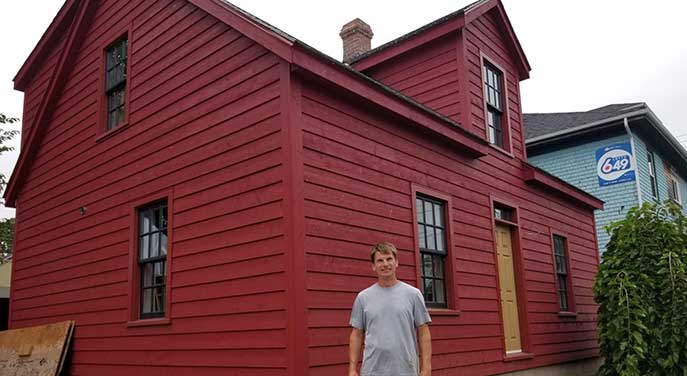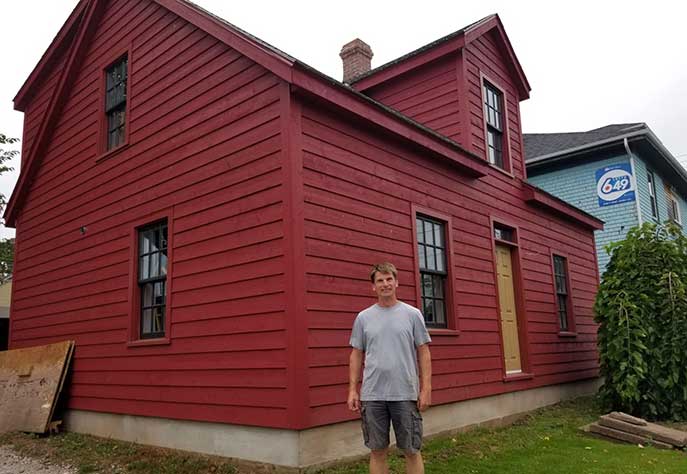- Second World War attack helped shape Bell Island’s history
- War, tragedy, and a Broadway hit all part of Gander’s celebrated past
- Proud captain sails to Canada’s other ‘distinct society’: Newfoundland
- What the heck is bike touring anyway? It’s an experience
- COVID panic? Keep calm and carry on with bike tour planning
- It’s not about where we travel but why
- ConnecTour Chronicles: Kindness comes in a bucket of ice and jug of water
- ConnecTour Chronicles: One man’s gear is another man’s gold
- ConnecTour Chronicles: A brush with heat stroke and then hypothermia
- ConnecTour Chronicles: Content to live with old mining town’s ghosts
- ConnectTour Chronicles: Highlights, lowlights and lessons learned so far
- ConnecTour Chronicles: An artistic treasure trove in a former biker bar
- ConnecTour Chronicles: Even in Banff, COVID-19 has left its mark
- ConnecTour Chronicles: A life-saving gift for our son-in-law
- ConnecTour Chronicles: A pool party on the Prairies
- ConnecTour Chronicles: Antique store owner revives memories
- A sudden, frightening crash sidelines one of our cyclists
- ConnecTour Chronicles: Out of the blue, an army on the prowl
- ConnecTour Chronicles: Cheap rural living brings brewery dream to life
- ConnecTour Chronicles: Warmshowers hosts have equally warm spirits
- ConnecTour Chronicles: A bicycle clinic that started with a bang
- ConnecTour Chronicles: Lodges hanging on by a thin fishing line
- ConnecTour Chronicles: A private fantasy world, rich in local and family history
- ConnecTour Chronicles: Reckless drivers are the scourge of cyclists
- ConnecTour Chronicles: Calgary bike trails a bridge between city and nature
- ConnecTour Chronicles: Wawa’s loyal support keeps country store going strong
- ConnecTour Chronicles: Learning to roll with one of this tour’s unexpected twists
- Amish follow a humble path to a simpler way of life
- ConnecTour Chronicles: Scaring away a middle-of-the-night invader
- ConnecTour Chronicles: Traumatic accident led former nurse to artistic success
- ConnecTour Chronicles: Ottawa family is all-in on car-free, cycling lifestyle
- ConnecTour Chronicles: Good luck dodging bad weather finally runs out
- Charlottetown’s heritage homes have a champion
- Cycling tour across Canada ends in St. John’s, N.L.
- Cross-country cyclists welcomed by St. John’s deputy mayor
Troy Media publisher Doug Firby is part of a group of Canadians who call themselves ConnecTour. Starting last May in British Columbia and ending in October in Newfoundland, they hope to make an 8,000-km bicycle journey across the country, discovering how the COVID-19 pandemic has reshaped our lives and sense of community. Watch for their reports on Troy Media. More information on the cycling tour is available at ConnecTour.ca. To help them meet their goal, click here.
 From its modest exterior of dark red wooden cladding, it would be easy to dismiss the small house in Charlottetown, PEI’s historic downtown Hillsborough district as cute but insignificant.
From its modest exterior of dark red wooden cladding, it would be easy to dismiss the small house in Charlottetown, PEI’s historic downtown Hillsborough district as cute but insignificant.
Under that cladding, however, is an historic log house built in 1844 – making it the third oldest known log home in the city. It was also at the centre of a controversy that saw it damaged and nearly razed by its previous owner, who was rebelling against an historic designation that brought with it tight controls on renovations.
The owner was so determined to get his way with the city that he deliberately made a hole in the house’s roof and took a chain saw to some of the logs at the house’s corners in the hope it would collapse. Apoplectic city officials threatened heavy fines if Campbell continued.
Then, three years ago, Paul Coles stepped in.
Coles runs a small heritage home renovation business. In addition to doing work for clients, he has bought, renovated and sold about 20 properties in Charlottetown over the past two decades. So when he heard the old log cabin was in peril, he stepped forward and offered to buy it in 2018. Not as an investment but to be his home.
“The previous owner was an anti-establishment drama guy,” says Paul, grinning as he recalled the difficult negotiations to take over the cherished house. “I’ve bought and sold some 20 properties; this was the worst closing I’ve ever had.”
 It was also a sign of the challenge Coles, 55, faced as he planned how to restore the building, while adding modern conveniences. He started by bringing in a friend who was an expert in restoring logs and knowledgeable in dendrochronology – determining a log’s age by studying its rings.
It was also a sign of the challenge Coles, 55, faced as he planned how to restore the building, while adding modern conveniences. He started by bringing in a friend who was an expert in restoring logs and knowledgeable in dendrochronology – determining a log’s age by studying its rings.
That friend cleaned and refinished the logs and replaced the ancient chinking with modern material.
Coles decided to expose the log walls inside while adding insulation and wiring on the outside of the building, covered by new wood cladding. While some purists object to not seeing logs on the outside, Coles says it was common 100-plus years ago to cover the exterior to prevent the logs from rotting.
ConnecTour was given a tour of the nearly complete project during a recent stopover in Prince Edward Island’s capital city. Because the house was moved one lot east onto an uneven foundation in 1923, it has a distinct tilt to it. One corner of the house sits a full 15 cm lower than the far corner, Coles says.
“At the end of the day, I wish I had disassembled the whole house and built a new foundation,” he says.
Renovations included replacing the rear half of the roof to add more room on the second floor, adding a steel beam to reinforce the structure and replacing the joists under the entire main floor. Tiled sections of the floor have in-floor heating.
Still, much of the home’s original charm remains, including the worn pine floor boards on the second floor.
The kitchen area has been opened up but – as with much of the house – materials from other houses have been repurposed to keep the time-period feel. The kitchen cabinets, for example, are clad in wainscotting taken from an old church, and a reclaimed window on an interior wall overlooks the staircase.
The exposed logs display the craftsmanship of the time, says Coles, when there were no mass-produced nails to hold the structure together. Instead, the structure is held together through wooden pegs and dovetail joints.
The central chimney – which once vented a large hearth – has a tilt of about 10 degrees. Coles says tilting chimneys were common at the time, built so the chimney exited at the roof’s peak.
Part of the home’s charm is the district its location. As recently as 20 years ago, it was a notorious bootlegging part of the city until a local MLA drove the charge for a crackdown on the illegal activity.
“Ten years ago, no one wouldn’t come down these streets,” says Jennifer Keenan, a friend and neighbour of Coles.
Coles has won eight City of Charlottetown Heritage Awards for his restoration work, which includes another nearby house that dates to 1810.
Houses aren’t the only old things he appreciates: Coles also has a 1952 Studebaker pickup truck, an original Datsun (now Nissan) 240Z sports car and a Corvette Stingray, both from 1993.
The ConnecTour team is heading to Nova Scotia, Cape Breton and then to Newfoundland in the last segment of their journey. Watch for updates.
Doug Firby is president of Troy Media Digital Solutions and publisher of Troy Media. For interview requests, click here.
The views, opinions and positions expressed by columnists and contributors are the authors’ alone. They do not inherently or expressly reflect the views, opinions and/or positions of our publication.
© Troy Media
Troy Media is an editorial content provider to media outlets and its own hosted community news outlets across Canada.


